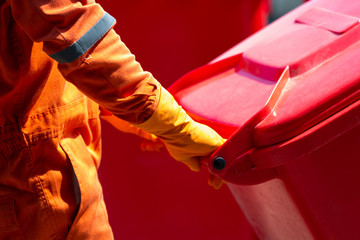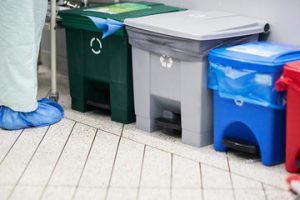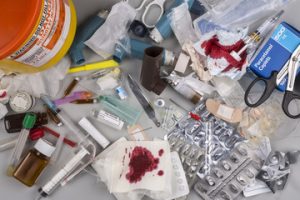Important Reason Why Waste Management Is Essential

To ensure that anatomical waste does not be absorbed into our environment, regulations and guidelines were formulated for those who produce medical waste on the way of treating and disposal of medical waste and yellow lidded sharps bins.
Sustainability in the environment continues to be a major concern and the emergence of new diseases like Ebola as well as Coronavirus (COVID-19) are cause for concern about the spread of disease and the specific handling needed for the disposal of orange clinical waste bags.
It is therefore more important than ever before for health personnel to know proper disposal and handling for biomedical waste.
What Is Biomedical Disposable Waste?
Biomedical waste is any product that results from an examination or vaccination. It may also be generate as part of research projects or other procedures that require testing biological.
Healthcare waste refers to all waste that is fill with liquid or semi-liquid blood or other materials that are potentially infectious (OPIM) that have the potential to cause human harm or infecting human beings.
Although there’s no standard definition for medical wastes, numerous provincial authorities distinguish the substances that are most likely to spread disease, and have guidelines for the treatment, collection, and transportation and disposal.
Biomedical Waste Can Include, But Isn’t Restricted To:
Non-anatomical wastes: objects that are clearly or tangibly contaminated by the blood of others or any other substance that may cause harm to others, such as gauze, bandages, as well as personal protective equipment such as gloves, gowns, plastic tubing, and many other clothes.
Yellow lidded sharps bins waste comprises scalpels lancets, needles, syringes or any other item that has be expose to infectious substances and use to the human’s skin (e.g. glass)
The pathological (or anatomical) wastes tissue, limbs and specimens (decant free of preservatives)
Wastes from chemotherapy Include masks, gowns gloves, masks and masks empty vials as well as empty intravenous tubing and bottles that were use to facilitate the administration of chemotherapeutic drugs
Lab wastes Stock and cultures that have be infect with human pathogens that cause illness

Who Generates Biomedical Disposables?
Most of healthcare yellow lidded sharps bins management is generated by facilities like hospitals, dentists’ offices, dental facilities as well as surgeries centers, research facilities and veterinarians. However, these aren’t the only ones. Funeral places and tattoo parlours generate biomedical waste.
What Is The Process For Biomedical Waste Recycling?
There are a variety of methods for the treatment of biomedical waste. The two most commonly used methods are:
Autoclaving:
It is to plan a high-temperature, high pressure steaming process, which renders pathogens that are infectious, after which the waste can be eliminate and transport to a dump. Autoclaving is perhaps the most popular treatment method.
Incineration:
Waste is expose to temperatures that promote combustion or to encourage burning. The rest of the ash is take to the landfill for disposal.
Certain substances, like hazardous waste, pharmaceutical waste and trace chemotherapeutic as well as toxic wastes, must be burn and separate to ensure that they are destroy properly.
What’s The Methodology To Regulate Biomedical Waste Management?
In the context of the Environmental Protection Act, the Ministry of the Environment regulates biomedical waste. It states that the waste has to appropriately separated from and processed.
In addition to provincial and federal laws and regulations, there are numerous guidelines and standards that define the way in which biomedical waste be treat from the time of creation to the point of disposal.
The latter includes Canadian Biosafety guidelines and standards and guidelines. which include those of the Canadian Council of Ministers of the Environment guidelines regarding the treatment of biomedical waste and a range of Canadian Standards Association (CSA) guidelines for the management of healthcare waste and the removal of yellow lidded sharps bins.
The biomedical waste produce from hospitals as well as other companies is full control. There are specific rules and guidelines that apply to biomedical waste generate by consumers across the vast majority of provinces.
The Biomedical Waste Categories, Definitions And Disposal Management
The waste produce by the health industry can be consider as hazardous waste. The health and environmental hazards that are associate with this waste can be identifie and the guidelines to deal with it could be different from waste generate in other industries.
-
Why Should We Pay More Care About The Risks Of Medical Waste Disposal?
In the position paper publish by WHO the United Nations’ World Health Organization (WHO) in the year 2000 in 2000, improper handling of the waste of medical treatment (primarily using hypodermic needles that were infect, and Syringes) cause the following epidemics across the globe:
- Hepatitis B, 21 millions of cases.
- Hepatitis C;
- HIV: 260,000 infections.
The graphs above illustrate how vital a suitable treatment of medical facility waste is. As per the WHO directive, disposal of clinical waste should be dealt with in the closest proximity to the place of its creation as feasible.
The risks involved in the transport and disposal of dangerous waste is substantial as the dangers associated with specific substances (e.g. the ones that can carry infectious diseases) is rising each day.
Properly-located and well-equipped facilities for disposing of waste could lessen the need for transporting dangerous substances.
A majority of the hospital’s waste contains bio-infect or biological objects that, despite the fact that they are of “communal” waste they actually pose a risk of contamination. This includes bandages, textiles, syringes and other things which are expose to infection because of contact with patients.
The bulk of the waste hospitals generate is compose of surgical instruments, such as surgical implants, and other instruments utilize in operations.

Biomedical Waste Of Various Types
Infectious Waste
Infectious waste is the safe disposal of medical waste that might be contaminate with pathogens (bacteria or parasites, viruses or the fungus) in sufficient quantity or in sufficient amounts to cause illness to susceptible hosts. This includes:
Cultures and stocks of infectious agents in labs
Toxic yellow sharps bin disposal products that result from autopsies or surgeries on patients suffering from infections (e.g. organ tissues, instruments or substances that have come into contact with blood or various bodily fluids);
The waste generate by patients infect in the isolation room (e.g. urine and feces, as well dressings that are damage or contaminate and clothing that has be heavy and soil from bodily fluids or blood);
the waste came in contact with patients on hemodialysis who have contract the disease (e.g. dialysis equipment, filters and tubing gloves, disposable towels for lab coats, aprons as gowns);
Pathological Waste
Materials that are infect and have dead tissue could contain harmful or transmittable infectious agents. This includes blood tissues, organs, body fluids and organs, body parts, human fetuses , and animal carcasses.
A subcategory of the collection of waste in the clinical environment that is to be pathological consists of different organs in the body and tissues that are either healthy or not.
Sharps
Sharps are objects sharp enough to puncture or cut skin e.g. blades, scalpels, knives such as needles for infusion sets and hypodermic needles that break glass nail, saws and more. They are capable of transmitting diseases directly to bloodstreams.
Sharps are generally consider to be highly hazardous medical waste even if safe from contamination or not.
Concerning sharp waste, special consideration should be pai to: transfusions, infusions and perfusion sets, including butterfly needles, cannulas and disposable razors, scalpel blades as well as hemodialysis set lab slides that break glass bottles (bacteriological and clinical laboratories) ampoules that contain solutions residues.
Two strategies are employ to less the risk of infection yellow lidded sharps bins create – through reducing sharpness and infectiousness.
The first is generally formulating treatment procedures for sharps which are typically more rigorous than those that are employ to treat clinical waste disposal.
Another option is the elimination of hard substances (typically in containers specifically design for this use) and the treatment by mechanical means of them or their enclosure.
Many states have strict rules for sharps containers and have measures to ensure puncture-proof and clearly labeled. Certain states require sharps to be sharp or by mechanical means in certain states, while some require them to be unable to be identifie.




